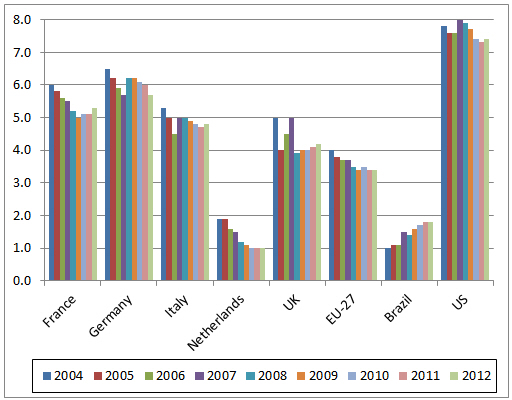



GLOBAL POULTRY TRENDS 2013: More Turkey Meat Eaten But Less Per Person
The human population has grown faster than turkey production in many countries where the birds are both reared and consumed, according to industry analyst, Terry Evans. The latest figures show the highest annual per-capita consumption in the US at 7.4kg.Although the annual quantity of turkey meat produced has increased two and a half times over the 30 years to 2012 – from 2.2 million tonnes to 5.6 million tonnes – the number of countries growing turkeys has hardly changed at around 70 out of a global total of some 220. Of the 70 at least 40 produce less than 10,000 tonnes a year and indeed, close to 80 per cent of world production comes from just five countries – the US, Germany, Brazil, France and Italy.
In most countries, population growth has outstripped increases in turkey production hence although total consumption has risen the uptake per person has fallen in almost all instances.
Because, for many countries, the quantity of turkey meat eaten per person is so small, data on consumption levels are available for only a handful (Table 1 and Figure 1). Sadly, in several instances, this does not make happy reading for producers.
| Table 1. Turkey meat consumption in selected countries (kg/person) | ||||||||||
| Region/Country | 2003 | 2004 | 2005 | 2006 | 2007 | 2008 | 2009 | 2010 | 2011 | 2012 |
|---|---|---|---|---|---|---|---|---|---|---|
| Austria | 5.2 | 6.0 | 6.9 | 6.0 | 6.5 | 6.2 | 6.4 | 6.3 | 6.3 | 6.1 |
| France | 6.2 | 6.0 | 5.8 | 5.6 | 5.5 | 5.2 | 5.0 | 5.1 | 5.1 | 5.3 |
| Germany | 6.4 | 6.5 | 6.2 | 5.9 | 5.7 | 6.2 | 6.2 | 6.1 | 6.0 | 5.7 |
| Italy | 5.2 | 5.3 | 5.0 | 4.5 | 5.0 | 5.0 | 4.9 | 4.8 | 4.7 | 4.8 |
| Netherlands | 2.2 | 1.9 | 1.9 | 1.6 | 1.5 | 1.2 | 1.1 | 1.0 | 1.0 | 1.0 |
| United Kingdom | 4.0 | 5.0 | 4.0 | 4.5 | 5.0 | 3.9 | 4.0 | 4.0 | 4.1 | 4.2 |
| EU-27 | - | 4.0 | 3.8 | 3.7 | 3.7 | 3.5 | 3.4 | 3.5 | 3.4 | 3.4 |
| Brazil | 0.5 | 1.0 | 1.1 | 1.1 | 1.5 | 1.4 | 1.6 | 1.7 | 1.8 | 1.8 |
| Canada | 4.5 | 4.4 | 4.5 | 4.5 | 4.5 | 4.9 | 4.5 | 4.2 | 4.2 | 4.3 |
| Mexico | 1.6 | 1.5 | 1.9 | 1.9 | 1.9 | 1.9 | 1.4 | 1.4 | 1.4 | 1.6 |
| Russian Federation | 0.6 | 0.8 | 0.9 | 0.8 | 0.7 | 0.7 | 0.5 | 0.7 | 0.8 | 0.8 |
| United States | 7.9 | 7.8 | 7.6 | 7.6 | 8.0 | 7.9 | 7.7 | 7.4 | 7.3 | 7.4 |
| - no data Source: AVEC annual reports |
||||||||||
In broad terms, the average uptake per person in the European Union is, at best, stable but it is generally acknowledged that there is a problem of its competitiveness which has become more pressing recently. Back in 2004, consumption averaged 4.0kg per person but since 2008, it has held steady at around 3.4 to 3.5kg.
After reaching a record 8.0kg in 2007, turkey consumption in the United States declined to 7.4kg in 2012, while the forecast for 2014 has slipped further to 7.1kg.
While the industry has successfully developed new added-value and innovative products, it is felt that it could do a better job informing consumers about these items and in their marketing of them. It is also considered that there are opportunities to market turkey to further processors who are important in catering for the food service sector.
The uptake of turkey meat in Canada has contracted from a peak in 2008 of 4.9kg to around 4.2 to 4.3kg per person.
Although at a low level, the quantity of turkey meat eaten in Brazil jumped rapidly from 0.5kg in 2000 to 1.5kg in 2007. Since then, growth has been much slower, uptake reaching 1.8kg per person in 2011/12.
In Mexico, consumption having been steady at almost 2kg per person throughout the years 2005 to 2008, then slumped to 1.4kg in 2009 although the latest figures for 2012 hint at a recovery towards 1.6kg.
The uptake per person in Russia has shown little movement in recent years around 0.8kg. However, a report late last year indicated that total consumption of turkey was projected to rise by five per cent in 2014 following a slump of nine per cent in 2013, when many Russian processors started using more low-cost chicken products in preference to turkey meat.

June 2014








